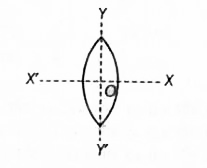An equiconvex lens is cut into two halves along i XOX and ii YOY as shown in the figure. Letf.f;f be the focal lengths of the complete lens. of each half in case i and of each half in case ii respectirely. Choose the correct statement from the followinga f = f f = 2fb f =2f f = fc f = f f= fd f=2f f = 2f
Correct option a f = f f = 2fExplanation:Since the lens is equiconvex the radius of curyature of each half is same say R. We know from Lens makers formulaIf we cut the lens along XOX then the two halves of the lens will be having the same radii of curvature and so focal length f = fBut when we cut it along YOY then we will have R1 = R but R2 = ∞
Related Solutions
An equiconvex lens is cut into two halves along and as shown in the figure. Let be the focal lengths of the complete lens, of each half in case , and of each half in case , respectively
Choose the correct statement from the following

View SolutionAn equiconvex lens is cut into two halves along (i) XOX^(') and (ii) YOY^(') as shown in the figure. Let f,f^(')f^('') be the focal lengths of the complete lens, of each half in case (i) , and of each half in case (ii) , respectively Choose the correct statement from the following
View SolutionAn equiconvex lens is cut into two halves along (i) XOX' and (ii) YOY' as shown in the figure. Let f, f ', f " be the focal lengths of the complete lens, of each half in case (i), and of each half in case (ii), respectively.

Choose the correct statement form the following.
View SolutionAs shown in the figure, a concave lens is cut into two parts along (i) XOX' and (ii) YOY'. Let f, f', f" be respectively the focus distances of each full lens in case (i) and the focal lengths of each half lens in case (ii). Select the correct statement from the following.
View Solutionएक समोत्तल लेंस को दो अरधकों में (i) XOX. तथा (ii) YOY. के अनुदिश चित्रनुसार काटा गया है | माना f,f', f" क्रमशः पूर्ण लेंस की प्रकरण (i) में प्रत्येक अर्धक की तथा प्रकरण , (ii) में प्रत्येक अर्धक की फोकस दूरियां है

निम्न में से सही कथन चनिये |
View SolutionFocal length of two lens are f and f^(') and dispersive powers are omega_(0) and 2omega_(0) .To form achromatic combination from these- (1) f^(')=2f ,(2) f^(')=-2f (3) f^(')=-f//2
View SolutionFocal length of two lens areandans dispersive powers are and.To form achromatic combination from these-
(1) (3)
View SolutionThe figure shows and equiconvex lens of focal length f. It the lens is cut along PQ, the focal length of each half will be

View SolutionThe figure shows and equiconvex lens of focal length f. It the lens is cut along PQ, the focal length of each half will be

View SolutionThe figure shows an equiconvex lens of focal length f. If the lens is cut along PQ ,the focal length of each half will be

View Solutionएक द्विउत्तल लेंस को दो भागों मं काटा गया है
(i) XOX’ के अनुदिश
(ii) YOY’ के अनुदिश यदि f,f’,f’’ तीनों स्थितियों में लेंस की फोकस दूरियां हैं तो निम्न में से कौन सा संबंध सही है?

View Solutionएक द्विउत्तल लैंस को दो भगों में काटा गया है-
(i) के अनुदिश (ii) के अनुदिश, यदि ff', f" तीनों स्थितियों में लैंस की फोकस दूरियां हैं तो निम्न में से कौन-सा सम्बन्ध सही है:

View Solutionବକ୍ରତା ବ୍ୟାସାର୍ଦ୍ଧ R ଓ ଫୋକସ ଦୂରତା f ହେଲେ ନିମୋକ୍ତ କାହା ପାଇଁ F = 2f ହେବ ?
View SolutionIf , choose the correct statement.
I. f(-x)=f(x)
II. F(-x)=-f(x)
III. F(2x)=2f(x)
View SolutionState whether the following statements are True (T) or False (F):
The focal length of the new combined lens of f1 and f2 each are f is 2f.
View SolutionIf f= {(1, 2), (2, -3), (3, -1)} then find:
(i) 2f, (ii) , (iii) , (iv)
View SolutionIf f= {(1, 2), (2, -3), (3, -1)} then find: (i) 2f, (ii) 2+f , (iii) f^(2) , (iv) sqrt(f)
View SolutionIf and f(0) = 3, then f(2) =
View Solutionएवं , तब
View Solution2f(x)=f'(x) And f(0)=3 , Then f(2)=
View Solution